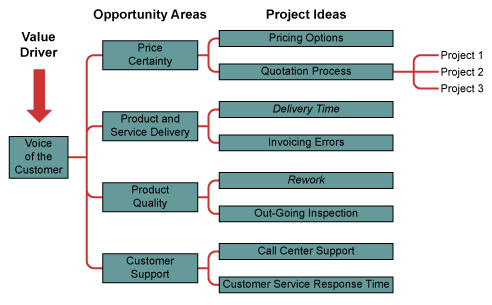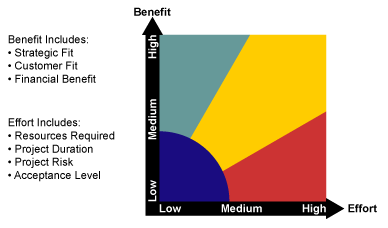
A business process improvement (BPI) effort is a systematic approach to help any organization optimize its underlying processes to achieve more efficient results. I use “effort” rather than “project” because I have found that using this terminology results in more motivation and less pushback on the part of Green Belts. After all, effort is truly what we are striving for.
The Basics of BPI Efforts
The same concepts for selecting the right BPI efforts apply to nonprofit, profit and government agencies; manufacturing and service industries; or any other type of organization. While the organizations may face varied challenges, how they apply BPI is fairly consistent across all industries.
Lean and Six Sigma BPI efforts assigned to Belts should be scoped for completion in three to four months with six months being the maximum allotted time. Although this may feel like an aggressive schedule, it takes into consideration the time team members must commit. If a BPI effort cannot be completed in this timeframe, scope it down or divide it into multiple BPI efforts. I wish I could say that all BPI efforts I have coached were properly scoped from the beginning; however, in many cases the team uncovered more during the Measure and Analyze phases than was originally anticipated. This is the time to work with the Champions and sponsors to update the BPI effort charter, including scope and timeline of the BPI effort.
Sources of Lean and Six Sigma BPI Efforts
There are two primary methods for identifying Lean and Six Sigma BPI efforts: top down and bottom up. Top-down efforts typically flow down from top-level management, including but not limited to Champion BPI effort ideas. Bottom-up refers to those BPI efforts that are identified either through brainstorming or additional findings in current BPI efforts by team members and personnel.
Most top-down BPI efforts are tied to strategic company goals in that at the executive management level there is usually a greater sense of urgency to focus on the customer. However, top-down BPI efforts may propose boiling the ocean. They may need to be broken down into Black Belt and Green Belt efforts.
Bottom-up BPI efforts may lack a direct tie to customer and company goals and strategies, but they can offer a number of other rewards:
- Leadership and peer recognition – This form of recognition is a powerful motivator, as it may lead to advancement in the company.
- Commitment from team members – Everyone has a voice in these projects and they appreciate when their voices are not only heard, but also are a part of the solution.
- Short-term gains – The short duration of the BPI effort affords a fairly immediate return.
Steps to Complete Before BPI Effort Identification
The following represent high-level steps to complete before practitioners begin BPI effort identification, either during the pre-Define or the actual Define phase:
- Establish BPI effort selection criteria upfront and adhere to it
- Identify customer requirements
- Identify performances standards
- Identify improvement objectives
Practitioners should link BPI efforts to the key business drivers of their company. The BPI effort selection process is critical to the success of a Lean and Six Sigma effort. The questions below can help practitioners to assess the effectiveness of their organization’s BPI effort selection process.
Selection Process Questions
- Does the BPI effort selection criteria align with corporate strategy and key performance indicators (KPIs)?
- Are data availability and resource availability included as one of the BPI effort selection criteria?
- Does the selection process consider the performance of corporate initiatives as part of the ranking function?
- Does the selection process take into account the impact of current BPI efforts on KPI’s?
- Does the selection process take into account the actual financial impacts that have been identified from improvements being implemented?
- Is there a documented process for determining how to prioritize BPI efforts?
- Does the selection process modify the weighting of criteria based on the current KPI values and the expected impacts to those KPIs from current BPI efforts?
- Does a selection committee or steering committee confirm the BPI efforts that should be implemented?
- Does the selection process identify the financial benefit and use a rating scale to determine scale of benefit?
- Do selection criteria include both impacts and feasibility?
- Does the organization follow the same process for BPI effort selection each time?
- Does it use a corporate scorecard to measure or monitor corporate performance to strategy?
- Does the selection criteria use a rating number per criteria rather than a simple check box to identify if the BPI effort meets criteria?
- Does the organization always use a ranking matrix that allows the various impacts to be weighted and rated?
- Is technology used to provide a consistent ranking of BPI efforts in the BPI effort pipeline?
Selecting and Prioritizing BPI Efforts
There are four primary value drivers to consider in BPI effort selection:
- Strategy: Where is the company going? Make certain that BPI efforts are aligned to the vision. Think about the competition or other similar businesses. Where is their vision?
- Voice of the customer (VOC): To succeed with customers, it is vital to know what they want. What are customers telling the company? How can they be better served? The company must be able to provide accurate, accessible and user-friendly information, and customers must feel the company is easy to do business with. Fast-changing customer needs underscore the importance of aligning business processes to achieve higher customer satisfaction. It is imperative in any BPI exercise that the VOC be known, and factored in, when reviewing or redesigning any process. Once practitioners identify customers’ key requirements, they can identify gaps between requirements and performance, which will bring additional BPI efforts to light.
- Voice of the business: Money is the life blood of most companies. Companies have gone bankrupt in organizational improvement efforts that did not pay attention to the money. Where is the money going? Where are the opportunities? What are the requirements? (In this case, requirements refer to policies and procedures such as internal audits, Sarbanes-Oxley, etc.) Benchmarks also should be considered within this category. BPI tools place a lot of emphasis on measurable results. Accordingly, benchmarks assume an important role in any BPI initiative. Depending on the lifecycle of the process in question, benchmarks may be internal, external or dictated by the senior management of the organization as aspiration targets.
- Internal processes: Practitioners should think about their core business processes. They will not have to improve every process, but some processes may contain opportunities for improvement. Establish or identify process owners for these processes. For any process to be controllable, it is essential that there be clarity on who owns it, and what constitutes success or failure of the process. These success and failure levels also help establish control limits for the process, and provide a healthy check on whether or not a process is meeting the desired customer objectives.
Key Tools for Use with Identifying BPI Efforts
There are many tools practitioners can utilize for identifying and prioritizing BPI efforts. The two primary tools I have had success with are the tree diagram and the benefits/effort matrix.
A tree diagram is simply a tool for organizing ideas (Figure 1). It branches off from the value drivers, which are major opportunity areas for value creation and Lean Six Sigma BPI efforts. Each value driver has many opportunity areas for BPI efforts. Many ideas that emerge from the opportunity areas are still too broad for a Lean Six Sigma BPI effort, and specific efforts must be identified. BPI effort ideas then go through the BPI effort selection process.

A benefits/effort matrixhelps practitioners must determine the benefits associated with a BPI effort compared to the effort (resources, time, etc.) necessary to proceed (Figure 2). Once practitioners identify BPI efforts, they should establish a labeling system, such as numbering them, and place them within the matrix. BPIs with high benefits that require low effort are the most desirable opportunities, while BPIs with low benefits but also low effort should be considered as potential quick hits. Opportunities that require high effort and offer low benefits are the less desirable.

Gathering Information for BPI Effort Selection
There are several information-gathering tasks that must be completed prior to launching a BPI effort:
1. Describe the business opportunity:
- What is the specific opportunity that will improve the success of your company?
- Who are the customers (internal and external) most affected by this opportunity?
- What critical-to-quality (CTQ) factors are associated with this opportunity?
- Where is this opportunity for improvement occurring?
- When or what is the time frame for this opportunity?
- To what extent is the opportunity measured by the key metrics?
The answers to these questions can be used to develop the BPI effort charter’s opportunity statement.
2. Scope the business opportunity:
- Name the business processes that deliver the product or service.
- Identify the output of the process. If there is more than one primary output, the opportunity may be too complex and may need to be scoped down.
- Develop the high-level process map. If there are more than two business processes involved, the opportunity may be too broad and it should be scoped down.
3. Define the business opportunity’s objectives and metrics:
- Write an operational definition of the defect.
- Set the primary and secondary metrics.
- Estimate the baseline performance of the metrics.
- Establish and confirm the goals or benchmarks of the opportunity.
- Prepare the data collection plan
4. Quantify the financial impact:
- List the financial metrics that will be used to track the improvement of the primary metric.
- Identify cost centers associated with the improvement effort.
- Determine the cost of the existing process.
- Consider hard and soft savings in your projections.
5. Launch the business process improvement effort:
- Identify stakeholders including process owner, sponsor and Champion.
- Determine if the opportunity should be assigned to a Black Belt or a Green Belt.
- Identify potential team members.
- Establish estimated timeline for duration of opportunity.
- Launch opportunity.
Making Successful Efforts
Most resistance to BPI stems from internal sources. Change is often difficult. Not just for the general staff, but also management. The employee base may resist BPI because of fears of headcount reduction or layoffs. Surprisingly, most companies have the proper staffing numbers in place to meet with existing challenges. Smaller scale implementations are often better. Some tips to keep in mind:
- Start with a small process that can be completed in a short timeframe.
- Set clear timelines.
- Do not spread resources thinly or focus only on the short-term payoff.
- Management and primary stakeholders must be involved, or else even a limited implementation will fail.